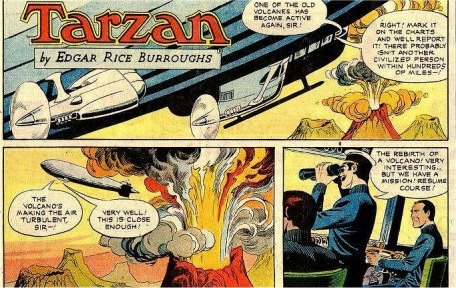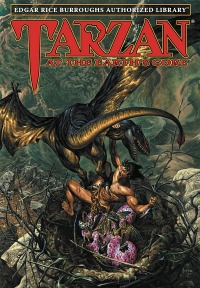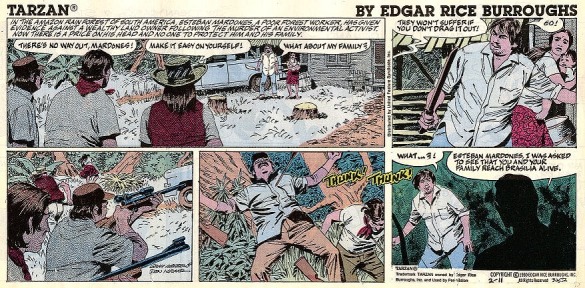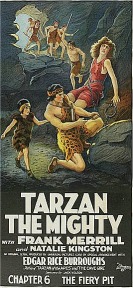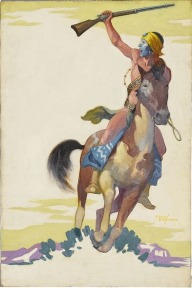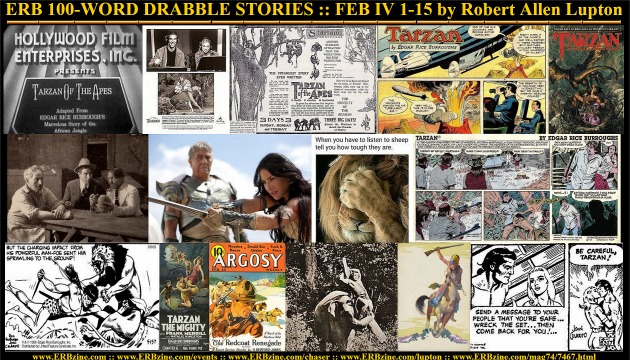
Official Edgar Rice Burroughs Tribute and Weekly Webzine Site Since 1996 ~ Over 15,000 Webpages in Archive Volume 7467 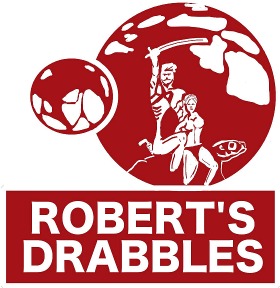 |
ERB 100-Word Drabbles
FEBRUARY IV Edition :: Days 1 - 15
See Days 16 - 28 at ERBzine 7467a
by Robert Allen Lupton
With Collations, Web Page Layout and ERBzine Illustrations and References by Bill Hillman
DON'T BOTHER ME WITH THE FACTS
February 1: On this day in 1919, Variety Magazine published a review of the silent film, “Tarzan of the Apes,” a ten-reel feature produced by the National Film Corporation and starring Elmo Lincoln and Enid Markey. The review praises Elmo and Gordon Griffith, who played Tarzan as a boy, but is critical of Enid Markey, whose career outlast them both.
The review also criticizes the film for lacking the pep of the original novel and mistakenly claims the novel’s original publication was in the “Evening World” newspaper and stating that it was reprinting in a popular fiction magazine. In truth, Tarzan of the Apes was serialized in several newspapers, the first of which was The New York Evening World, beginning on January 6, 1913. The novel’s first appearance was in All-Story Magazine, October 1912.
Read a synopsis of the article at: https://www.erbzine.com/mag14/1439.html
The drabble for today, “Don’t Bother Me With The Facts,” was inspired by that error in the Variety article.
DON'T BOTHER ME WITH THE FACTS
![]()
“That’s because it did.”
‘Naw, you got it backwards. He sent photographs of
both with his letter.”
“I was sure I was right. Even so, I’d rather give
kudos to the Evening World than that pulp magazine. Sorry”
“Sorry don’t cut the mustard. You know our policy.
Make sure you know the facts before you distort or ignore them.”
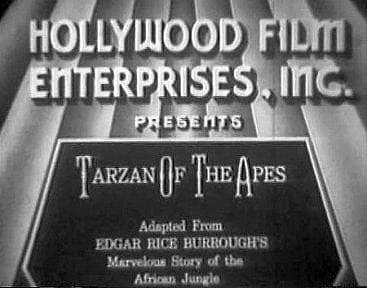
BEHIND THE VEIL
February 2: On this day in 1962, actor Michael T. Weiss was born in Chicago, Illinois. Weiss was the voice of Tarzan for all thirty-nine episodes of the animated television series, “The Legend of Tarzan” and the 2002 Disney film, “Tarzan and Jane.” He’s appeared in several films including “Howling IV: The Original Nightmare,” “Freeway,” “Dinosaur,” ”Confessions of an Action Star,” and “Sex and the City 2."
On television, his work includes, “The Pretender,” “Days of Our Lives,” “Dark Shadows,” “Red Shoe Diaries,” and “Burn Notice.” He’s voiced characters in “Justice League,” “Jackie Chan Adventures,” “The Mummy,” and Adam Strange in “Batman: The Brave and the Bold.’"
Read all about the Disney television series at: https://www.erbzine.com/mag0/0014.html
The drabble for today, “Behind the Veil,” was inspired by Disney’s version of Tarzan.
BEHIND THE VEIL
![]()
Tarzan shook his head. “The beauty hides danger.”
“What dangers. I see flowers, antelopes gamboling in the meadows, elephants showering each other, and birds frolicking in the trees.”
“Everything in the jungle eats something else. Snakes wait to eat the unwary bird, crocodiles lurk near the elephants, and cheetahs and lions stalk the antelopes. Even some of those flowers are deadly.”
“Nonsense. Look at that sleeping lion. He’s so cute.
I could just give him a cuddle.”
“Please don’t. Never disturb a sleeping lion. He may
wake up and remember that he’s hungry.”
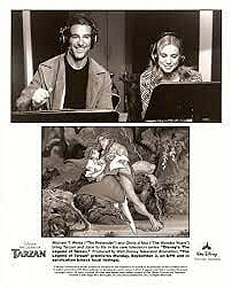
February 3: On this day in 1918, an article in the New York Times discussed the film, ”Tarzan of the Apes” starring Elmo Lincoln and Enid Markey. The film was almost constantly sold out at the Broadway Theatre and advertisements said, “Attend the Matinees to Avoid the Crowds at Night.”
Among other things, the article challenged several claims about the film, especially exaggerated travel claims, the number of extras hired, and set construction details. The publicity claimed that trips were made to Brazil, Peru, Louisiana, Great Bear Lake, and Banff, Canada covering 12,000 miles by train and 6,000 miles by steamer. Three hundred native huts were built in the Brazilian jungles along with wooden huts, similar to those at Army cantonments fully screened against insect invasion, were built at a small place called Itejuca, sixty miles inland from the Amazon River. Eleven hundred natives, forty high-priced acrobats, four lions, six tigers, several elephants, and eighteen living apes were used in the production.
A summary of the Times article is located at: https://www.erbzine.com/mag63/6305.html
The drabble for today is “Did You Sneeze Or Are Those Your Brains,” and it was inspired by the publicity claims made for the first Tarzan film. Credit to Groucho Marx and Will Rogers for a little guidance.
DID YOU SNEEZE OR ARE THOSE YOUR BRAINS
![]()
“Really? All I know is what I read in the papers.”
“Is that a famous quotation?”
“Not yet, but it should be.”
“People won’t believe these preposterous exaggerations
about filming the movie.”
“That’s show business! People should be open minded
and make up their own minds.”
“Yes, people should be open minded, but not so open
minded that their brains fall out!”
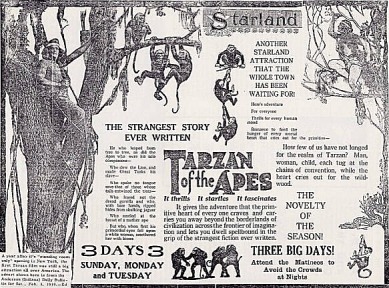
February 4: On this day in 1966, the John Celardo written and illustrated story arc, “Tarzan and the Captive Princess” began in the Tarzan daily comic strip. It ran for 74 days and ended on April 30, 1966.
The story begins with Tarzan helping a tribe build a bridge. A chimpanzee brings Tarzan a necklace and other pieces of jewelry. Intrigued, Tarzan follows the chimp to find a drugged woman in a treehouse in the March 10th episode. She is the Princess Irena, ruler of a tiny European monarchy and has been betrayed and held captive by her safari leaders. Tarzan’s chimp companion is named “N’diki.
The entire story is available at: https://www.erbzine.com/mag46/4655.html
The illustration is the April 1, 1966 episode.
The drabble for today is “Betrayal” and it was inspired by the story arc “Tarzan and the Captive Princess.”
BETRAYAL
![]()
Tarzan nodded. “I’m sure they did. References, like guarantees, are but little pieces of paper.”
“They promised to guide me for six weeks and guaranteed that I would get photographs of hundreds of animals. They lied. As soon as we were in the jungle they turned on me and held me for ransom.”
“I’ll take you home.”
“They promised!”
“Princess, some promises are as snow. Beautiful at
first, but when they melt, they leave no trace that they ever existed.”

DEATH IS THE PRICE OF INATTENTION
February 5: On this day in 1978, the Russ Manning Sunday Tarzan Strip story arc, “The Dead Moon of Pellucidar” began. The story ran for one year, fifty-two weeks, and ended on January 28, 1979. This was the penultimate story arc by Manning, the last one, “Tarzan and the Games of Ibizzia” would end on June 24, 1979.
The story may be read in its entirety at: https://www.erbzine.com/mag21/2137.html
In the story, Tarzan returned to Pellucidar and discovered Van Horst, whose adventures were told in ‘Back To The Stone Age.” Van Horst is living as a savage and believed that his love, La-Ja was killed by Sagoths. The two escape and earthquake, meet up with Princess Dian, battle horibs, sagoths and mahars. The group are captured and discover that the mahars, evil reptilian overlords have been hiding on the moon that causes the ‘Land of Awful Shadow.” You should read the rest of the story.
The illustration is July 23, 1978 and was selected because I liked it.
The drabble for today, “Death is the Price of Inattention, was inspired by the story arc, “The Dead Moon of Pellucidar.”
DEATH IS THE PRICE OF INATTENTION
![]()
“Unfortunately, true, Tarzan.”
“When last I was here, the mahars were broken and
defeated, if not completely destroyed. Your people were safe.”
“Indeed, we scoured the world, sought them out, and thought we’d killed them all. We’ve lived in peace since then, and our people have forgotten their oppression.”
Tarzan said, “It’s the same everywhere. Complacency is the mother of evil and sloth is its father. Evil is like a weed. It grows in the untended garden.
VERY HOSTILE TAKEOVER
February 6: On this day in 1956, the story arc, “The Rescue of Bobby Barnes,’ began in the Tarzan daily comic strip. Written by Dick Van Buren and illustrated by John Celardo, the story ran for eighty four days.
The son of a wealthy industrial family, the Barnes, becomes lost in the jungle and Tarzan rescues the boy while teach him bravery, honesty, and other important life lessons.
All eighty-four pages may be read at: https://www.erbzine.com/mag38/3864.html
“Very Hostile Takeover,” is the drabble for today, inspired by the lesson taught by Tarzan to Bobby Barnes in the story.
VERY HOSTILE TAKEOVER
![]()
Tarzan taught him to fish and hunt. After safely reaching Leopoldville, Tarzan discovered Bobby’s parents were murdered in a plot to take over their company. Tarzan exposed the guilty and ensured that Booby inherited the business.
“Safety in business is an illusion. As in the jungle, there are always victims. Predators and prey is the way of the world. Remember that.”

NOWHERE FAST
February 7: On this day in 1929, Edgar Rice Burroughs finished writing “Tarzan at the Earth’s Core,” a book he began writing on December 6, 1928. Start to finish, 77,000 words in two months. Sounds fast, but that’s not quite 1300 words a day.
The novel was serialized in Blue Book Magazine over seven months beginning in September 1929 and concluding in March 1930. Frank Hoban drew the covers for is of the issues. Metropolitan Books published the first edition on November 28, 1930 with a wraparound cover by J. Allen St. John.
Just recently, Edgar Rice Burroughs Inc. released a new edition of the book with bonus material from the ERB archives
and a magnificent cover by Joe Jusko. https://edgarriceburroughs.com/
Details about the novel's publishing history and numerous illustrations are archived at. https://www.erbzine.com/mag7/0721.html
The drabble, “Nowhere Fast” for today is and it was inspired by the apparent time and directional paradoxes in Pellucidar – the land at the Earth’s core. A tip of the Fire Inc. for inspiration.
Jason Gridley said, “Tarzan, we’re lost, but we have to find Abner Perry. He needs our help.”
NOWHERE FAST
![]()
Don’t know. We should hurry.”
“If we don’t know where we are or where we’re going, we’ll just be going nowhere fast!”
“We’ll find people. We’ll ask questions.”
“We’re running out of time.”
“Yes, we should seek him, but in the context of a world where the sun never moves, time doesn’t matter. We’ve plenty of time, if we live long enough. We won’t run out of time, but could run out of life.”
DO YOU FEEL LUCKY
February 8: On this day during the Civil War, actor Edward Elkas was born in New York City Elkas played “Dirty Eddie” in the 1919 silent film “The Oakdale Affair,” based on the novel of the same name by Edgar Rice Burroughs.
There is no evidence that Clint Eastwood modified the name and used it for the nickname of Inspector Callahan in a series of films years later. Considering that the film, “The Oakdale Affair,” has long been considered a lost film, that would have been highly unlikely.
Edward Elkas Hirsh, whose birth name was Edward Elkas Hirsch, appeared in 88 films between 1911 and 1926, never making the change to talking pictures. This seems somewhat strange
considering that he had appeared on stage prior to his film career, but not so strange considering that he was 64 when he filmed his last picture and died seven years later at age 71.
Elkas is the actor on the left in the photograph.
Details about the film, The Oakdale Affair are available at: https://www.erbzine.com/mag7/0765a.html
The drabble for today, “Do You Feel Lucky,” was inspired by the name of Elkas’s character in “The Oakdale Affair,” a touch of “Billy Jack,” and a hint of “Dirty Harry.”
DO YOU FEEL LUCKY
![]()
Eddie put a knife to her throat.
The sheriff said, “I’ll shoot you.”
“You’d kill her just like that?”
“No, you’d kill her and I’d kill you. Just like that!”
Bridge hit Eddie from behind with a broken baseball
bat. The sheriff laughed. “Caught him unaware. Even a man with a knife
has to know his limitations!”
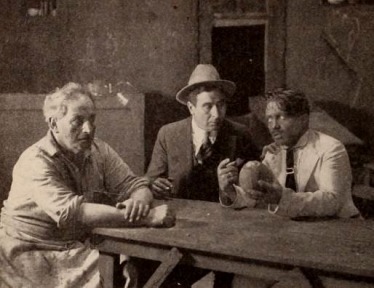
THERE WILL BE BLOOD
February 9: On this day in 1953, actor Ciaran Hinds was born in Belfast, Northern Ireland. Hinds played Tardos Mors in Disney’s “John Carter.” Hinds also appeared in “Harry Potter and the Deathly Hallows – Part 2.” “Tinker Tailor Soldier Spy” and “Belfast,” for which he is currently nominated for the Best Supporting Actor Academy award. He was Mance Rayder in Game of Thrones. He had voice roles in Frozen and Frozen II.
The previous list is by no means all inclusive, Hinds has appeared in several films and television shows and is credited with over a hundred stage appearances. IMBD lists 122 credits for the actor.
Tardos Mors was the Jeddak of Helium and the grandfather of Dejah Thoris.
Read about the film at: https://www.cartermovie.com/
The drabble for today, “There Will Be Blood,” was inspired by the relationship between Dejah Thoris and her grandfather, Tardos Mors.
THERE WILL BE BLOOD
![]()
“She will rule after her father, my son Mors Kajak.
Who would dare gainsay her?”
“I would have thought you’d want a grandson to help
defend the country and rule it.”
Dejah Thoris, my granddaughter, is my comrade-in-arms,
my confidant, and my co-conspirator. Who could ask for more?”
“I love her and seek permission to marry her.”
“No man speaks for Dejah, she speaks for herself.
Please don’t make her angry. She tends to settle disagreements at sword
point.”
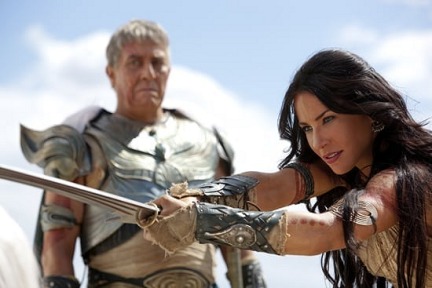
AWEEM AWAY
February 10: On this day in 1922, Edgar Rice Burroughs began dictating the ninth book in the Tarzan Series, “Tarzan and the Golden Lion,” into his Ediphone.
Publishing details, illustrations, and details about the novel abound at: https://www.erbzine.com/mag4/0495.html
A new edition of the book is available from ERB Inc., with a magnificent cover by Joe Jusko, and a wealth of bonus material from the author’s archives.
In this novel, Tarzan and Jane rescue a lion cub that they name Jad-bal-ja, which means the golden lion in the language of Pal-ul-don. Tarzan raised the cub to adulthood. Later Tarzan is drugged and captured by the savage priests of Opar and faces sacrifice to the flaming god at the hand of La, the high priestess who loves Tarzan.
La and Tarzan flee Opar, but enter a valley ruled by savage gorillas. The Golden Lion follows Tarzan, but so does the evil Estaban Miranda, who looks just like Tarzan and wants to loot the jewel and gold vaults of Opar.
Will the golden lion arrive to help Tarzan survive the gorillas or will Estaban arrive first, kill Tarzan and La and loot the lost city of Opar. Well, you’ll have to read the book to find out.
Today’s drabble, “Aweem Away,” was inspired by “Tarzan and the Golden Lion,” with a little help from the Tokens.
AWEEM AWAY
![]()
“Lion, I don’t see a lion. Wait! You said, your lion. YOU OWN A LION!”
“It’s more like the lion owns me.”
“But I don’t see him.”
“I know his scent.”
“I don’t hear him.”
“Lions don’t thrash around and make noise while they hunt. A male lion hides, and maybe sleeps while he waits for prey to come to him.”
“Sleeps, but we could be in danger.”
“He’ll wake if necessary, but for now, in the jungle, the lion sleeps tonight!”

FOREST PRIMEVAL
February 11: On this day in 1990, the Gray Morrow illustrated and Don Kraar written Tarzan Sunday Page story arc, “In Forests Dark,” began and ran for twelve episodes in the “Sunday Funny Papers.” What A great title!
Estaban Mardones is prepared to testify in court against a conglomerate logging illegally in the rain forests of Brazil, but the loggers, who have found gold, have hired bounty hunters to kill him before he reaches Brasilia. Tarzan escorts Estaban, his wife, and his child, through the rain forests battling the jungle predators and bounty hunters along the way.
The entire story is available to read at: https://www.erbzine.com/mag35/3532.html
The drabble for today, “Forest Primeval,” was inspired by the story arc, “In Forests Dark.”
FOREST PRIMEVAL
![]()
Tarzan said, “My pleasure. As I child I learned not
to call forest that sheltered me a jungle.”
“I hope I can help protect the forest.”
“You shouldn’t have to. Destroying the rainforest
to make money, is the same as burning down your home to cook breakfast.”
Estaban nodded. “I agree. It’s so much easier to make a desert than it is to make a forest.
FIFTEEN CHAPTERS
February 12: On this day in 1966, actor, gymnast, policeman, and stuntman, Frank Merrill, passed away at age 72 in Los Angeles, California. Born Otto Adolph Stephan Poll, Merrill won over fifty gymnastic titles in the United States. He was the fifth actor to play Tarzan on the silver screen. Merrill worked as a stunt double for Elmo Lincoln in “The Adventures of Tarzan” before being cast in the lead for “Tarzan the Mighty, a fifteen chapter film serial. He played Tarzan once more, in “Tarzan the Tiger.”
His voice was considered unsuitable for talking pictures and he spent the rest of his life happily as a recreation director for the Los Angeles Park Commission and a volunteer gymnastics instructor at the YMCA.
Details about the film, Tarzan the Mighty, are available at: https://www.erbzine.com/mag5/0592.html and for Tarzan the Tiger:
https://www.erbzine.com/mag5/0593.html
The drabble for today, “Fifteen Chapters,” includes all fifteen chapter titles from the film serial. Sort of gives you the whole story in 100 words.
FIFTEEN CHAPTERS
![]()
Tarzan dodged a lion’s leap. “Fear the flames of hate in the fiery pit.”
“I’ve a guide.”
“He’s a jungle traitor and will lead you to the jaws of death in the leopard’s lair.”
Like a thief in the night, the guide left Mary lost in the jungle. She was facing death along perilous paths.”
Tarzan battled the guide, the enemy of Tarzan and saved Mary. “He deserved a dead reckoning, but the reckoning of law’ll have to do.”
BURN IT DOWN
February 13: On this day in 1937, Argosy Weekly published the final installment of “Seven Worlds To Conquer,” a Pellucidar novel which was published by ERB Inc. as “Back To The Stone Age.” Burroughs’s working title was “Back to the Stone Age: A Romance of the Inner World.” In those days, the term ‘romance’ was almost interchangeable with ‘adventure.’
Neither the novel nor Edgar Rice Burroughs received so much as a cover mention. The cover illustration by V. E. Pyles was for “The Redcoat Renegade” by Patrick Lee. Other writers with stories in the issue included Theodore Roscoe, H. Bedford Jones, Donald Barr Chidsey, and Frank R. Pierce.
The drabble for today is "Burn It Down," and it was inspired by the title, “Back to the Stone Age.”
BURN IT DOWN
![]()
Tarzan nodded. “Indeed, dinosaurs, mastodons, and cavemen living side by side. I was happy there.”
“Why are they living in a stone age and we live in such modern times?”
“Timing, what man can build, man can destroy. Forgotten and ancient civilizations are built atop each other. Our cities cover cities vanished from mankind’s memory.”
“So we should expect a return to the stone age?”
‘Yep, civilization is just one bad day from living
in caves.”
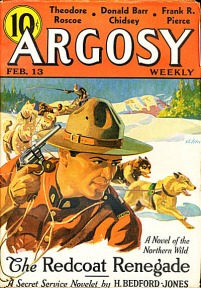
A TRUNK FULL OF MEMORIES
February 14: On this day in 1924, Actor Kamuela Searle, died of cancer in Los Angeles, California. Searle, born Samuel Cooper Searle in Wai’ohinu, Ka’u, Hawaii, played the son of Tarzan, Korak, in the 1920 film serial, “The Son of Tarzan.” Searle replaced western actor, Jack Hoxie, who was originally cast in the role. Searle spent a month living in a desert to toughen up for the role.
It was reported in several places, that Searle was killed by the elephant during the filming of the scene where the elephant rescues Korak, who is bound to a stake, and carries him to safety, that Searle was slightly or seriously injured, depending on the source. Searle survived, nevertheless the publicity surrounding his supposed death helped at the box office.
Kamuela enlisted in the Army at the outbreak of WW1 and was injured and medically discharged. He gave up acting in 1921, had a short career as a professional wrestler and, then became a sculptor and painter for three years prior to his death. His five screen credits are, “Fool’s Paradise” in 1921, “The Son of Tarzan” in 1920, “The Sea Wolf” in 1920, “Male and Female” in 1919 and “The island of Desire” in 1917.
Details about the serial, “The Son of Tarzan,” abound at: https://www.erbzine.com/mag5/0589.html
“A Trunk Full of Memories,” is the entirely fictitious drabble for today and was inspired by the legendary elephant injury controversy.
A TRUNK FULL OF MEMORIES
![]()
The elephant slapped Searle’s hand with his trunk.
Searle grabbed another handful. The trainer said,
“He hates for folks to eat his food. You should apologize. Maybe feed him
a cantaloupe or something.”
Later, while filming a pivotal scene, in which Searle was bound to a stake, the elephant lifted Searle and smashed him repeatedly to the ground. “What the hell?” screamed the director?
The trainer pulled the elephant away. “I warned him. an elephant never forgets, but he never forgives either!”
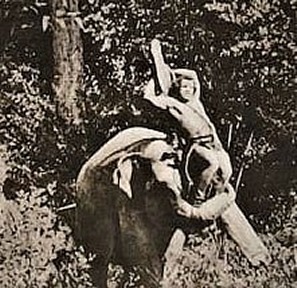
February 15: On this day in 1933, Edgar Rice Burroughs Inc. published the first edition of “Apache Devil.” The edition had a print run of 5.238 and a vibrantly beautiful dust jacket by Studley Oldham Burroughs.
Besides his personal experiences in the southwest with the U. S. 7th Cavalry, ERB credited several reference books that he used to guide him in historical accuracy. The following six books are by no means the complete list.
The Marvellous Country: Three Years in Arizona and New Mexico, the Apache's Home by Samuel Woodworth Cozzens 1873
Thrilling Days in Army Life by General. George. A. Forthsyth 1900
Lives of Famous Indian Chiefs by Norman B. Wood
The Frontier Trail by Colonel Homer W. Wheeler
The Land of Poco Tiampo by Charles. F. Lummis
Geronimo's Story of His Life by S.M. Barrett, 1907
For the complete list and more information about “Apache Devil,” I recommend https://www.erbzine.com/mag7/0775.html#DJ
The drabble for today is “Kill The Devils,” and it was inspired by the underlying sentiment, as I see it, in Apache Devil,” by Edgar Rice Burroughs. One of the first rules of warfare is to demonize your enemy.
KILL THE DEVILS
![]()
Private Bohdan replied, “I’m from Delaware. I miss it. No devils in Delaware either.”
“I wonder why we call them ‘devils’?”
The Captain heard Johnson’s question. “We call them
devils because they’re our enemies. I suspect they call us worse.”
Johnson complained. “They weren’t my enemy in Minnesota.
They seem pretty much like me.”
Captain said, “Of course they do. That’s why we call
them devils. It’s easier to shoot a devil than another man!”
